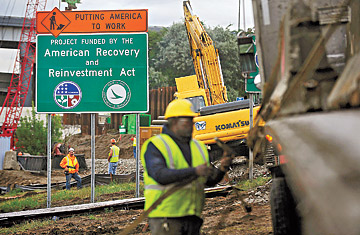
Construction workers on the site of an infrastructure project at the junction of Interstates 490 and 77 in Cleveland, Tuesday 30 June 2009. The project is being funded by government stimulus money as part of the American Recovery and Reinvestment Act.
Fueled by coke zero and a double-chocolate protein bar, Vice President Joe Biden is roiling, ranting, being his usual self. Five mayors and county executives listen in silence on the other end of a White House speakerphone as the Delaware ear bender tries to ride herd on the stampede for dollars known as the American Recovery and Reinvestment Act, the $787 billion monster that is the largest domestic-spending effort in U.S. history. "My rear end is on the line just like yours," Biden barks, surrounded by a flock of aides in his West Wing office. "I'm the guy in charge of this deal. So if this doesn't work, it's me."
When Congress passed the stimulus bill in February, it came as both good news and bad news to the Obama White House. The good: never before had an Administration had so much money to spend on voters in need--to rebuild public buildings, save jobs, weatherize homes and fund community health centers. The bad: rarely has the passage of a measure been accompanied by such skepticism about the government's ability to spend the money wisely or well.
And ever since, public doubts about the stimulus have, if anything, deepened. The economy deteriorated faster than economists expected, with unemployment now predicted to exceed 10% next year, higher than the White House had projected in January. While that might under normal circumstances make any stimulus more popular, voters have been spooked by the enormous deficits Washington is running up as it tries to right the economy. In 2009 alone, the U.S. government will take on debt equal to about 13% of its economic output, and by 2016 the U.S. debt is projected to top 70% of GDP, twice the 2000 level. Poll after poll has shown a steady erosion of confidence in the stimulus measure; one survey found that 45% of voters believe it should be abandoned midstream.
Killing Frisbee Golf
Biden saw this day coming. In February, the Vice President and Ron Klain, his chief of staff, penned Barack Obama a memo predicting that spending $787 billion on tens of thousands of projects through hundreds of agencies would create opportunities for waste and corruption on an unprecedented scale. Biden suggested that someone with heft needed to be put in charge. During one of their weekly lunches, the President read over the memo, nodded and then handed it back to Biden. Do it, he said. Months later, Biden still laughs about how it happened. "Last memo I've written him," he says. "No more memos."
After decades in the Senate (where he was no slouch at snagging funds for his home state of Delaware), Biden knew his way around a rotten pork barrel. So he set up an in-house watchdog group, with a team that would grow to eight and a charge to keep the spending clean, quick and defensible. Economists will tell you that the most important part of a stimulus is getting the money into the economy fast, where it can replace lost consumer and business spending and keep people employed. But Biden's team knew that it's just as important to maintain public confidence in the enterprise, especially in an age of $500 million helicopters and Bridges to Nowhere. At the White House, this worry translated into a simple if fuzzy standard for deciding which projects pass muster: prudence. "It's like pornography," says Edward DeSeve, the senior adviser to the President for recovery and reinvestment. "You know prudence when you see it."
